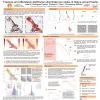Poster #179, SCEC Community Models (CXM)
The SCEC Community Rheology Model (CRM)
Poster Image:

Poster Presentation
2020 SCEC Annual Meeting, Poster #179, SCEC Contribution #10606 VIEW PDF
nnual Meeting.
The preliminary GFM comprises 23 provinces, each with a set of lithologic layers. It is shared as lat-lon files of province boundaries, tables with depth intervals and rock types for each province, and petrological descriptions for each rock type. A table of preferred mineral flow laws, a description of mixing laws and assumptions, and a table of whole-rock flow laws for each of the GFM rock types is also provided. The whole-rock flow laws are analytical expressions, and may be integrated into codes such as RHEOL_GUI (Montesi and Leete, 2018), enabling quick and accurate calculations of effective viscosity and differential stress. Transient and shear zone ductile rheologies will be added during the coming year.
Using GFM lithologies, CTM temperatures, and assuming tectonically-relevant bulk strain rates (10-13 s-1 to 10-15 s-1) and fluid-saturated conditions, we have calculated effective viscosity profiles for the GFM provinces. These profiles show steady-state effective viscosity of the southern California lithosphere away from shear zones. Minimum effective viscosities are generally between 1020 and 6×1021 Pa s in the lower crust, and between 5×1017 and 3×1019 in the upper mantle. Since fluid-saturated conditions do not apply in the southern California upper mantle, these mantle viscosity estimates are low and will be refined to reflect “damp” conditions (COH = 480 ppm). Some viscosity profiles show a mid-crustal minimum (e.g., Basin and Range, Mojave) while others (e.g., Sierra Nevada E and W, Peninsular Ranges) do not. This crustal minimum results from a gabbro layer at the base of crust with a much higher effective viscosity than the overlying felsic crust.
SHOW MORE
The preliminary GFM comprises 23 provinces, each with a set of lithologic layers. It is shared as lat-lon files of province boundaries, tables with depth intervals and rock types for each province, and petrological descriptions for each rock type. A table of preferred mineral flow laws, a description of mixing laws and assumptions, and a table of whole-rock flow laws for each of the GFM rock types is also provided. The whole-rock flow laws are analytical expressions, and may be integrated into codes such as RHEOL_GUI (Montesi and Leete, 2018), enabling quick and accurate calculations of effective viscosity and differential stress. Transient and shear zone ductile rheologies will be added during the coming year.
Using GFM lithologies, CTM temperatures, and assuming tectonically-relevant bulk strain rates (10-13 s-1 to 10-15 s-1) and fluid-saturated conditions, we have calculated effective viscosity profiles for the GFM provinces. These profiles show steady-state effective viscosity of the southern California lithosphere away from shear zones. Minimum effective viscosities are generally between 1020 and 6×1021 Pa s in the lower crust, and between 5×1017 and 3×1019 in the upper mantle. Since fluid-saturated conditions do not apply in the southern California upper mantle, these mantle viscosity estimates are low and will be refined to reflect “damp” conditions (COH = 480 ppm). Some viscosity profiles show a mid-crustal minimum (e.g., Basin and Range, Mojave) while others (e.g., Sierra Nevada E and W, Peninsular Ranges) do not. This crustal minimum results from a gabbro layer at the base of crust with a much higher effective viscosity than the overlying felsic crust.
SHOW MORE





















